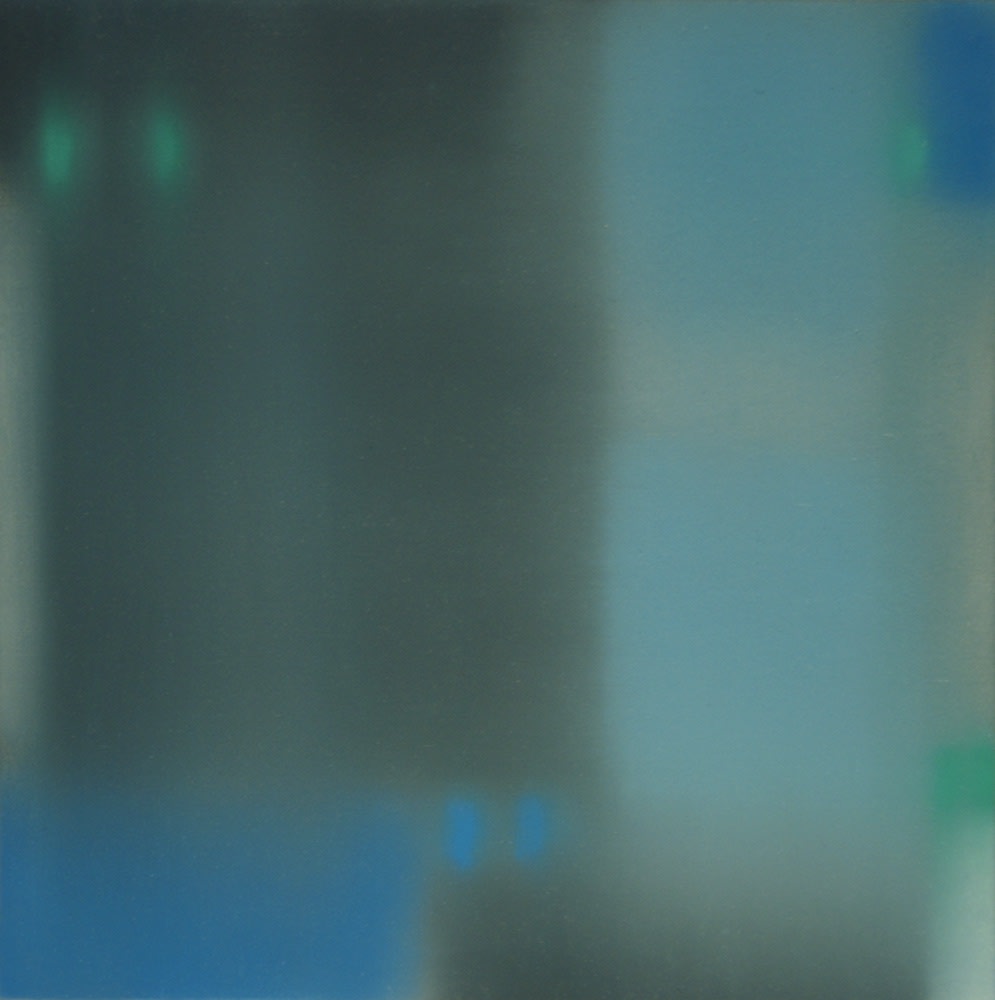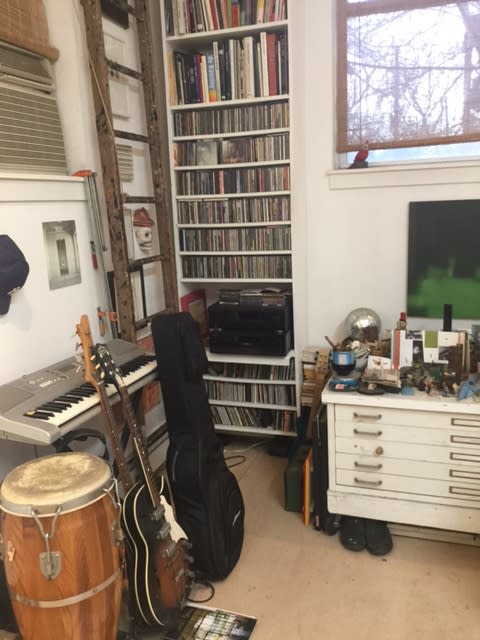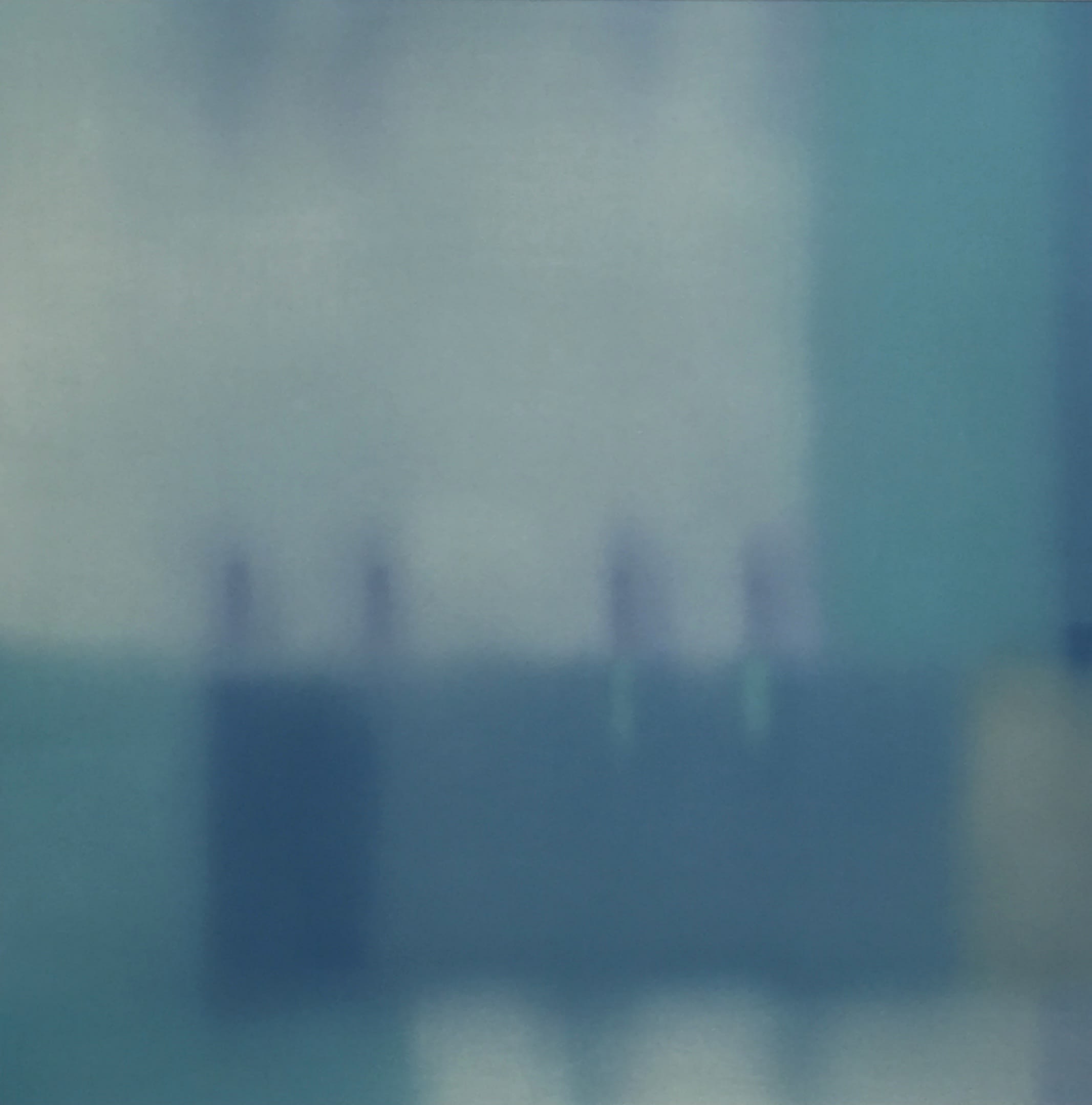
Every week, we'll be sitting down with one of our gallery artists to discuss their work, process, inspiration, and stories. This week we're speaking with Julian Jackson.

"Winter Pages 6," Julian Jackson
Julian Jackson's work has recently taken a departure from soft-focused studies of light to more formal linear works influenced by architecture. Connecting his series is a reverence for nature and art history, a precarious sense of balance, and an exploration of color. We met up in his studio in Brooklyn to dive into the evolution of his work, the early artistic influences that still shape his aesthetics, and finding inspiration in the origins of the world.

What are some of your earliest memories relating to art?
I was interested in art almost from the time I could hold a pencil or a crayon. I think my first drawings as a budding young artist were probably Popeye, because I loved Popeye, and when I started studying drawing I graduated to pyramids and cowboys and weight lifters and dragsters. I was always drawing. I lived in Richmond, Virginia, and we had a wonderful museum there called the Virginia Museum of Fine Arts, and sometimes our parents would take us there after church and drop us off. That was much better than church for me, just to be able to roam around this place. I remember when I was about 10 or 12 and I was standing in front of this Paul Klee drawing, this very childlike drawing of a girl with curly hair. It had a tossed off, insouciant quality, and I was thinking "Maybe I can do that." Then this person came up next to me and she scoffs and says "my nine year old could do that!" And I was thinking, well, if a 9 year old could do that, I can definitely do that! I went home and I tried to make a copy of this drawing and I just couldn't get that quality of ease that he had. He was one of my first favorite artists.

By the time I got to junior high all I wanted to do was hang out in the art room, and I was lucky enough to have some great teachers throughout school. Adults would ask me what I wanted to do with my life and I would say "I want to be a lawyer," because it sounded like a real profession. But I had an uncle who was also a painter and he worked in the Guggenheim Museum, and I didn't know him that much because he didn't come home to Virginia that often, but I knew I had this uncle who was an artist and he lived in New York, and that sounded like a wonderful ambition. So, through high school I just kept working on drawing, and then I took painting in college. It's been a long, long road, but here I am still working nearly 40 years later.
Your life was so rich in art from the beginning. Were there any early influences that ended up affecting your aesthetic later in life?
There are two that I can think of that really mark my trajectory as an artist. One of them is that I used to love to climb trees and get way up as high as I could go and feel the sway back and forth. I learned how to soften my vision; I could make a blur out of my eyes so that nothing was in focus, and it was just the coolest feeling to sway at the top of the tree and see the light coming through the leaves and the branches. I loved being outdoors and experiencing light and enjoying the light.

The other pole to that, for me, was the church that we went to when I was a kid. When you grow up in Richmond, the dominant style is colonial and everyone's house looks like you're in Williamsburg or something, and everyone's into antiques. But I was really drawn to modern architecture from an early age, and the church I went to was this beautiful modern building. It had these big beams that marched along the sides of the inside and soared up into the center so that it made this great open space marked by these columns. It was like looking up into the bottom of an ark. Then the windows were very Mondrian-esque, rectangular abstract windows done in shades of gray. I can honestly tell you that I was thinking about that building a lot while I was conceiving this latest series of work, which is a bit of a departure from what I had been doing. So, that combination of the natural and the manmade were formative experiences for me.

What else are you inspired by now?
I'm kind of a restless person. I like to mix things up. So one year I might be very interested in these austere, hard edge forms, but next year it might be skies again. But going back ten years, there are always interests that remain: an interest in form, and an interest in a fluidity of form, and then this interest in light. One of the phenomena that really fascinates me is that we are constantly in motion. Our perspective around us is always changing and there's this constant sense of flux. It's interesting to me to then try to capture that with the very still medium of painting where everything is finally fixed. Once you make the last brushstroke and decide that the painting is finished, it might be like that for 500 years. But until you finish the painting it's all up in the air. I think that's one of the really fascinating things about art is that it has infinite possibilities, really, in any given form or structure. It's one of the freest zones you can ever enter. I work in rectangles like many other artists, but within that rectangle there's just so much room for movement. So, any one painting never quite seems like the whole story; it seems like a tiny piece of a story. I think that's why I like working in series and why I like working in diptychs because then the story is allowed to continue.
I also love art history and I've had the opportunity to travel a lot and go to most of the great museums around the world. I've been lucky enough to see a lot of the Vermeer paintings in their original locations, and I did a whole series based on analyzing Vermeer's structures, which are very formal, and then softening the colors. I love that a piece of art is a place itself you can go to visit again and again. It's a great pleasure for me to, for instance, go to the Met, and every time I go to the Met I go to the Vermeers, and every time they're always there. They have the same information, but they might register differently to me emotionally depending on how I'm feeling or where I'm at in my life. But just knowing that they exist, that they're there, that if I'm lucky enough I can make the trip and go see them, it's very comforting to me. Those kinds of pilgrimages mean a lot to me. I like connecting to that greater idea with my own work. So, sometimes art is a reference, sometimes nature's a reference. It's all kinds of things.

For this latest series, I was really inspired by a recent trip to Tokyo that my wife and I took, where we spent a lot of time seeing their temples. They have this beautiful structure with sliding panels that can change the configuration of the rooms. They're these beautiful, logical, architectural forms. Everything is presented to you, it's a very carefully curated experience. Every window frames a view that's chosen for you, and the whole garden around the temple is carefully designed so that every window in the temple has this very particular perspective on it. I love the degree of care that's in that concept of carefully considering every element of what it is you're seeing and how you're experiencing things. I was referencing that in my latest series. I've also done a lot of building over the years to support myself. I was a carpenter for a long time, and a cabinet maker, and working in that very precise world of architecture is also something I'm referencing: an interest in precision, a carefully considered relationship of form to form. While my previous works were very focused on the outdoors, these are more about being inside, finding that stillness where you're shielded from that constant movement and really just getting to experience that space.
How long have you been in the city?
I've lived in the city for 30 years, I came up here in the 80s.
Oh, I was just wondering, if you'd moved here recently, if perhaps that was what took you from painting the outside natural world to these interior spaces.
Well, I swing back and forth. The earliest work I was doing in New York was very nature-based. I look back on it now and call it my compost period. I was working with these very natural forms like bones and plants and trees, and thinking about microorganisms, and I was re-imagining those things in an evolutionary way. Gradually my focus returned to light and form, and I realized that's what I was always the most interested in, so that's what I've focused my, let's call it, "mature" work on.

Do you have an idea of what it is about light that you're drawn to so much, or the particularities of it that you try to capture in your work?
I think it's the essential element in a way. Light is us, and we are light, just like Joni Mitchell's lyric, "We are stardust, we are golden." We are light! Back in the compost days I was reading a lot of natural history and one of the books that really impressed me was by Rachel Carson. It was about the sea, but in the beginning of the book she describes the beginning of the world and how from a ball of solid rock all of life was formed and how crucial light was in that transformation. Now having read a lot about it, I understand that it's cosmic, it's this thing that everything on our planet stems from, that it plays a role in all these different kinds of transfigurations. That also goes back to that constant state of flux that I'm really interested in.
I think the reason I'm drawn to the work I'm doing right now is because after all of this study of movement and leading this active life, I reached a point where I really need some stillness. I've made so many variations of these pieces where I was moving these elements around and always trying to leave this sense of movement. With these new pieces, I'm trying to bring a kind of zen-like clarity, a sense of focus, and a sense of stillness to the work. But light is always an essential ingredient. Artwork, it wouldn't exist without light. Going back to Vermeer, he's somebody that I look at again and again because his colors are so subtle, his use of light is so particular. His feeling for it has that kind of metaphysical beauty that really draws me in.

What is your process like? Is it connected at all from one series to the next?
Well, the process for me is always kind of similar, because these earlier paintings, even though they wind up being very soft, they start with a lot of form. I'll have a palette in mind, and then from that color sense I'll start with laying out areas, but then it's a unique experience each time from there. I use very thin paint. I'm not about gesture and that hectic sense of energy. My work is more about stillness in a lot of ways; that paradox of stillness suggesting movement, not through slashy paint work, but through subtlety of normal relationships. What I'm after in my work is always balance that feels slightly like it could tip over, like a ballerina on pointe. She can't stay there forever. If you throw a ball in the air, it's going to come down, but at some point it'll hover for just a second, and that's the kind of sense I'm after.

The surface of my work table usually has these pages open while I'm working, where I'll have forms that I cut out and move around the page to study the composition and relationships and how the colors react to one another. I pace around as I'm painting, and I'll come over to my table and I'll take one of the shapes and I'll move it a little bit, and keep something like this in flux until I decide it's settled and I'll glue it down. They're these collages that inform my work in a lot of ways. That's kind of my drawing practice while I'm working.
With this current series, there's a lot more drawing that goes on. I use charcoal, and I move the lines around until I get something I'm interested in. It's more of a direct process: I'll start making colors, I'll start making forms, I'll move things around until they land. I haven't been taping the edges of the lines within the space. I've just been painting them freely, and it brings me to a place where I can calm that madness from the constant motion and just focus. All I have to do is concentrate on the edge. Then it's a matter of bringing it to a sense of a perfect blur that I'm after. I'm happy to say I've had a few commissions based on my older pieces so I've been able to stay in contact with that work, which I feel is essentially me, but I'm very much enjoying these pieces. They're challenging and interesting in a whole different way than the other works.

There's a collection of instruments over there. Are you a musician as well?
I'm an amateur musician. I like to play around with it. I mostly play acoustic guitar and sing folky stuff. I''ve been writing some songs lately, which has been fun.
Is there any overlap between painting and writing songs?
I love music and always listen to music while I'm working. I think my work has kind of a rhythm to it. I'm sure music finds its way into my work, but I don't know how. When I was younger I was a dancer, and I know that affected my sensibilities a lot. It made me very aware of being a body that's inhabiting this space, this world. I think that's when I became very attuned to my surroundings. Every day there was something new happening in the sky, some new light phenomenon. Like the snowstorm last week, it made me feel like I was six years old again! Last Sunday the sky was the deepest series of blues I've ever seen, and stuff like that is so exciting to me. It makes me so grateful to be a conscious being on our planet. It's incredible!

"Vespers 2," Julian Jackson
Explore more of Julian Jackson's work here.
Comments
Your many talents amaze me Julian!
What a beautiful insightful interview of a fascinating artist whose work continues to evolve and inspire me.